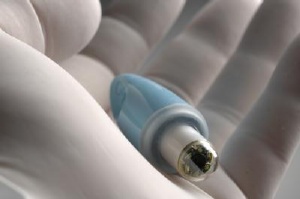Jun 4 2008
Images of the inside of the intestine can be obtained even today: The patient swallows a camera that is no larger than a candy. It makes its way through the intestine and transmits images of the intestinal villi to an external receiver which the patient carries on a belt. This device stores the data so that the physician can later analyze them and identify any hemorrhages or cysts. However, the camera is not very suitable for examinations of the esophagus and the stomach. The reason is that camera only takes about three or four seconds to make its way through the esophagus - producing two to four images per second - and once it reaches the stomach, its roughly five-gram weight causes it to drop very quickly to the lower wall of the stomach. In other words, it is too fast to deliver usable images. For examinations of the esophagus and the stomach, therefore, patients still have to swallow a rather thick endoscope.
 The camera pill is not larger than a candy. It can be swallowed by the patient. The doctor steers it through esophagus and stomach by a magnetic device. (Credit: Fraunhofer)
The camera pill is not larger than a candy. It can be swallowed by the patient. The doctor steers it through esophagus and stomach by a magnetic device. (Credit: Fraunhofer)
In collaboration with engineers from the manufacturer Given Imaging, the Israelite Hospital in Hamburg and the Royal Imperial College in London, researchers from the Fraunhofer Institute for Biomedical Engineering in Sankt Ingbert have developed the first-ever control system for the camera pill. "In future, doctors will be able to stop the camera in the esophagus, move it up and down and turn it, and thus adjust the angle of the camera as required," says IBMT team leader Dr. Frank Volke. "This allows them to make a precise examination of the junction between the esophagus and the stomach, for if the cardiac sphincter is not functioning properly, gastric acid comes up the esophagus and causes heartburn. In the long term, this may even cause cancer of the esophagus. Now, with the camera, we can even scan the stomach walls." But how do the researchers manage to steer the disposable camera inside the body? "We have developed a magnetic device roughly the size of a bar of chocolate. The doctor can hold it in his hand during the examination and move it up and down the patient's body. The camera inside follows this motion precisely," says Volke.
The steerable camera pill is constructed in much the same way as its predecessor: It consists of a camera, a transmitter that sends the images to the receiver, a battery and several cold-light diodes which briefly flare up like a flashlight every time a picture is taken. One prototype of the camera pill has already passed its first practical test in the human body. The researchers demonstrated in a self-experiment that the camera can be kept in the esophagus for about ten minutes, even if the patient is sitting upright.